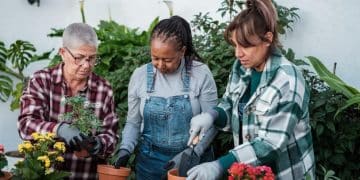Latest Strategies to Engage Volunteers in Community Action Projects

The latest strategies for engaging volunteers in community projects involve leveraging technology, offering flexible roles, prioritizing diversity and inclusion, and focusing on impact and recognition to create meaningful experiences.
Are you looking to boost engagement in your community projects? Discover the latest strategies for **what are the latest strategies for engaging volunteers in community projects?** and make a real difference.
Understanding the Evolving Landscape of Volunteer Engagement
The landscape of volunteer engagement is constantly evolving, influenced by societal shifts, technological advancements, and changing expectations. Adapting to these changes is crucial for organizations aiming to attract and retain dedicated volunteers.
Traditional methods of recruitment and management are no longer sufficient. Today’s volunteers seek meaningful experiences, flexible commitments, and a clear understanding of their impact.
The Impact of Technology on Volunteerism
Technology has revolutionized how volunteers connect with organizations. Online platforms and mobile apps make it easier than ever to find opportunities, track hours, and communicate with team members.
The Changing Motivations of Volunteers
Understanding what motivates modern volunteers is key to designing engaging roles. Many are driven by a desire to make a tangible difference, acquire new skills, or connect with like-minded individuals.
- Offer flexible schedules and remote volunteering options to accommodate busy lifestyles.
- Provide opportunities for skill development and training to enhance their expertise.
- Showcase the positive impact of their contributions through data and storytelling.
In conclusion, embracing technology and understanding volunteer motivations are crucial first steps. In the next section we will look at the strategy of creating meaningful experiences.

Creating Meaningful Volunteer Experiences
Creating meaningful experiences is at the heart of successful volunteer engagement. Volunteers are more likely to stay committed when they feel valued, appreciated, and connected to the mission of the project.
This involves designing roles that align with their interests and skills, providing regular feedback, and fostering a supportive and inclusive environment.
The Importance of Recognition and Appreciation
Recognizing and appreciating volunteers is essential for boosting morale and retention. Simple gestures like thank-you notes, public acknowledgements, and small tokens of appreciation can go a long way.
Fostering a Sense of Community and Belonging
Volunteers thrive in environments where they feel a sense of community and belonging. Creating opportunities for socialization, team-building activities, and peer support can strengthen bonds and increase engagement.
- Implement a volunteer recognition program that celebrates their achievements and milestones.
- Organize social events and team-building activities to foster camaraderie.
- Encourage peer-to-peer support and mentorship to create a sense of community.
In conclusion, prioritizing recognition and community will encourage volunteers to feel a sense of belonging. Let’s move on to how to implement effective communication strategies.
Implementing Effective Communication Strategies
Effective communication is the backbone of any successful volunteer program. Clear, consistent, and open communication ensures that volunteers are well-informed, engaged, and aligned with project goals.
This involves establishing clear communication channels, providing regular updates, and actively soliciting feedback from volunteers.
Utilizing Technology for Communication
Technology offers a range of tools for streamlining communication with volunteers. Email newsletters, social media groups, and mobile apps can be used to disseminate information, share updates, and facilitate discussions.
Active Listening and Feedback Mechanisms
Creating opportunities for volunteers to share their feedback and suggestions is crucial for continuous improvement. Active listening, surveys, and feedback forms can provide valuable insights into their experiences and needs.
- Establish clear communication channels such as email newsletters, social media groups, and mobile apps.
- Provide regular updates on project progress, upcoming events, and volunteer opportunities.
- Actively solicit feedback from volunteers through surveys, feedback forms, and one-on-one conversations.
In conclusion, communication strategies ensure that volunteers have all the information they need to make a real difference. Let’s explore the importance of diversity and inclusion.

Prioritizing Diversity and Inclusion
Prioritizing diversity and inclusion is essential for creating a welcoming and equitable volunteer environment. A diverse team brings a range of perspectives, experiences, and skills to the table, enriching the project and better serving the community.
This involves actively recruiting volunteers from diverse backgrounds, providing inclusive training, and addressing any barriers to participation.
Creating a Welcoming Environment for All
Creating a welcoming environment for all volunteers involves being mindful of cultural differences, providing accommodations for individuals with disabilities, and promoting a culture of respect and understanding.
Breaking Down Barriers to Volunteerism
Identifying and addressing barriers to volunteerism is crucial for ensuring equitable access. This may involve providing transportation assistance, childcare support, and flexible scheduling options.
- Actively recruit volunteers from diverse backgrounds through targeted outreach and partnerships.
- Provide inclusive training that addresses cultural sensitivity and unconscious bias.
- Address any barriers to participation such as transportation, childcare, and language access.
In conclusion, prioritizing diversity and inclusion is essential for creating welcoming environments for volunteers. In the next section we will look at how to measure impact and tell your story.
Measuring Impact and Telling Your Story
Measuring the impact of volunteer efforts and effectively communicating the story of the project is crucial for attracting new volunteers, securing funding, and building community support. Quantifiable data, qualitative feedback, and compelling narratives can showcase the value of volunteer contributions.
Sharing success stories, statistics, and testimonials can demonstrate the tangible difference volunteers are making and inspire others to get involved.
Quantifying the Value of Volunteer Contributions
Quantifying the value of volunteer contributions involves tracking volunteer hours, calculating the economic impact of their services, and measuring the outcomes of their efforts. Reporting on these metrics can demonstrate the return on investment of volunteer programs.
Sharing Stories of Transformation and Change
Sharing stories of transformation and change can bring the impact of volunteer efforts to life. Highlighting the experiences of beneficiaries, volunteers, and community members can create an emotional connection and inspire action.
- Track volunteer hours, calculate the economic impact of their services, and measure the outcomes of their efforts.
- Share stories of transformation and change through testimonials, videos, and social media posts.
- Use data and narratives to demonstrate the tangible difference volunteers are making in the community.
In conclusion, measuring your impact, and sharing the story is key. This in turn may benefit from building partnerships. Let’s explore this in more detail in the next section.
Building Strategic Partnerships and Collaborations
Building strategic partnerships and collaborations can expand the reach and impact of community projects. Partnering with other organizations, businesses, and government agencies can provide access to resources, expertise, and new networks of volunteers.
Collaboration can also foster a sense of shared ownership and increase community engagement.
Identifying Potential Partners and Allies
Identifying potential partners and allies involves researching organizations and individuals who share similar goals and values. Networking events, community meetings, and online platforms can provide opportunities to connect and build relationships.
Creating Mutually Beneficial Relationships
Creating mutually beneficial relationships involves defining clear roles and responsibilities, establishing shared goals, and providing reciprocal value. Partnerships should be based on trust, transparency, and a commitment to collaboration.
- Identify potential partners and allies who share similar goals and values.
- Create mutually beneficial relationships based on trust, transparency, and a commitment to collaboration.
- Leverage partnerships to expand the reach and impact of community projects.
Building strategic partnerships allows you to provide access to resources and expertise. In conclusion, this is the last strategy, and can be used to make a tangible difference in the community.
| Key Point | Brief Description |
|---|---|
| 📱 Technology Integration | Use online platforms and apps to connect with volunteers. |
| 🤝 Community Building | Foster connections through social events and peer support. |
| 📢 Effective Communication | Establish clear channels and solicit volunteer feedback. |
| 🌍 Diversity & Inclusion | Recruit diversely and address participation barriers. |
Frequently Asked Questions
▼
The first step is to clearly define the project’s goals and the specific roles volunteers can play. This clarity helps attract individuals who are truly interested and aligned with the project’s mission.
▼
Technology enhances engagement by providing online platforms for communication, scheduling, and tracking volunteer hours. It also allows for remote participation and easier access to resources.
▼
Diversity brings different perspectives, skills, and experiences to the project, enriching the team’s problem-solving abilities and ensuring the project better serves the community.
▼
The impact can be measured by tracking volunteer hours, calculating the economic value of their contributions, and assessing the outcomes of their activities through surveys and feedback.
▼
A meaningful experience is one where volunteers feel valued, appreciated, and connected to the project’s mission. It involves providing regular feedback, recognizing contributions, and offering opportunities for growth.
Conclusion
In conclusion, successfully engaging volunteers in community projects requires a multifaceted approach that combines effective communication, technology, and a commitment to creating meaningful experiences. By implementing these strategies, organizations can build strong, dedicated teams that make a tangible difference in the community.





